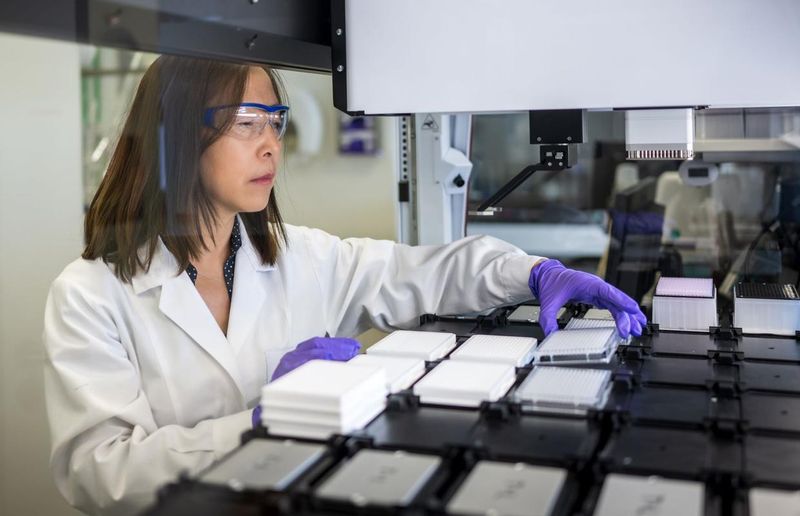Redefining R&D: How Immunoscience is Driving the Pipeline of the Future

What does the word “immunoscience” conjure up for you? Does your mind jump straight to inflammatory conditions, like asthma and atopic dermatitis (AD)? Or maybe you think about treatments for autoimmune diseases, or the lifesaving power of vaccines? Or does it all sound a bit too vague to know what to think?
Most of us are familiar with the basic concepts of the immune system. When we get hurt or sick, or our body tries to evade something harmful, the immune system comes to our rescue: it’s our body’s defense against foreign invaders, protection against disease, and it uses a multitude of different processes to safeguard us.
“Immunoscience” is our way of looking at the role the immune system plays not only in how diseases work, but also how we can treat them.
Our goal at Sanofi is to become the leading immunology company, leveraging our legacy of scientific expertise in inflammatory diseases and innovation in vaccines to deepen our overall understanding of the immune system and how it is implicated in many different medical conditions.

Houman Ashrafian
Executive Vice President, Head of Research and Development
We can only push the frontiers of science by being disruptive, so our scientists are pioneering an approach that is designed to ignite discovery and advance therapeutic options for patients across the spectrum of human disease.
Beyond the conventional immunological categories of conditions like ulcerative colitis or rheumatoid arthritis, most diseases – even those as diverse as Alzheimer’s disease, coronary disease or cancer – have an immunological component. We are studying the pathways, cell types and interactions that make up these components to identify the broader immune mechanisms that might help us combat disease, and then matching them to potential therapeutic areas. We are working on new treatments designed to harness the immune system, either by applying immune-mediated mechanisms to fight diseases or by rebalancing the immune responses that go awry in systemic, chronic diseases.
An Immunology Powerhouse, Driven by Pipelines in our Products
Our immunoscience approach enables us to apply deep biological pathway knowledge and expertise across different, sometimes seemingly unrelated therapeutic areas. This lays the groundwork for more “pipelines in a product,” or medicines that can treat a multitude of conditions and, consequently, have the potential to help many more patients. It is already driving our progress in areas as diverse as transplant, diabetes, immunology, neurology, hematology, oncology, rare diseases, and vaccines.
We start by diving deeply into the immune pathways themselves, without the confines of specific therapeutic areas. From there, we improve our understanding of how different diseases unfold within the body, and we can ultimately use that knowledge to identify opportunities for therapeutic intervention that provide benefit across multiple conditions.
This approach is already making inroads into diseases driven by excessive type 2 inflammation, an immune response that originally evolved to protect us against pathogens and other environmental dangers. We are working on multiple compounds that target the type 2 inflammatory pathway in different ways, including a Nanobody that blocks IL-13 and TSLP, two signalling proteins found at different points of that pathway. Targeting both proteins is more powerful than addressing either of them alone, and leveraging dual mechanisms can both help maximize the chance of efficacy and more precisely target specific disease pathologies in different patients. Many diseases use multiple immune pathways; for instance, one patient’s asthma often does not work the same way as another’s. Combinations can help us find more patients who can benefit from specific medicines. In this case, we hope it will result in a treatment for multiple respiratory conditions, such as asthma and chronic rhinosinusitis with nasal polyps.
We are also advancing therapies that could usher in a new era in neuroinflammation, including one that inhibits CD40L, the ligand that plays a role in immune regulation. As we studied this drug’s ability to reduce brain lesions in multiple sclerosis, we understood that the same mechanism could potentially make a difference for patients with Type 1 diabetes.
Additionally, we have multiple programs targeting OX40L in phase 2 studies for the treatment of atopic dermatitis, asthma, and hidradenitis suppurativa, with trials on deck for alopecia areata, celiac disease, and systemic sclerosis.
Beyond type 2 inflammation, we are pursuing a range of approaches, including natural killer (NK) cell engagers for the treatment of cancer and in vivo CAR-T cell therapy for indications across oncology, immunology and other disease areas.
AI at Scale in R&D
These programs are part of an industry-leading pipeline of potential first- and best-in-class medicines that our teams are advancing with the help of data science, computational expertise, and disruptive technologies, including artificial intelligence (AI). Through our target discovery engines, drug design modeling, and use of digital patient populations to accelerate research, AI is helping us unravel disease biology and deliver novel therapies more quickly than ever before.
In addition to accelerating R&D, AI also helps us bring precision medicine to more patients. We know from experience that like asthma, nearly all diseases unfold differently in each patient. Through the lens of immunoscience, our scientists are investigating the biological pathways that drive heterogeneity in disease. Our goal is to identify and develop specific treatments to better serve specific groups of patients, as with our dual IL-13- and TSLP-targeted Nanobody. AI helps us do this by enabling us to synthesize and compute tremendous amounts of data to help “crack the code” of disease and find the combination of targets and approaches with the best chances for success.
Most importantly, as this broader understanding of our biology evolves, it helps us appreciate the role of the immune system to preserve what truly makes us each unique. It will enable us to develop treatments that safeguard our health by addressing individual disease and preserving the "healthy" self.
The Future of R&D
At Sanofi, we are knocking down borders between organ systems and traditional disease categories to apply our immunoscience platform across our R&D organization. This pathway-focused, system-level approach to R&D is built on the foundation of decades of scientific leadership. Our scientists, rooted in immunoscience and supported by AI, are ushering in a new age of R&D, where our commitment to precision medicine and our patient-driven understanding of disease mechanisms and pathways will give rise to transformative new options for people around the world.
Explore More

Digital “Twinning”: Clinical Trials Powered by AI
